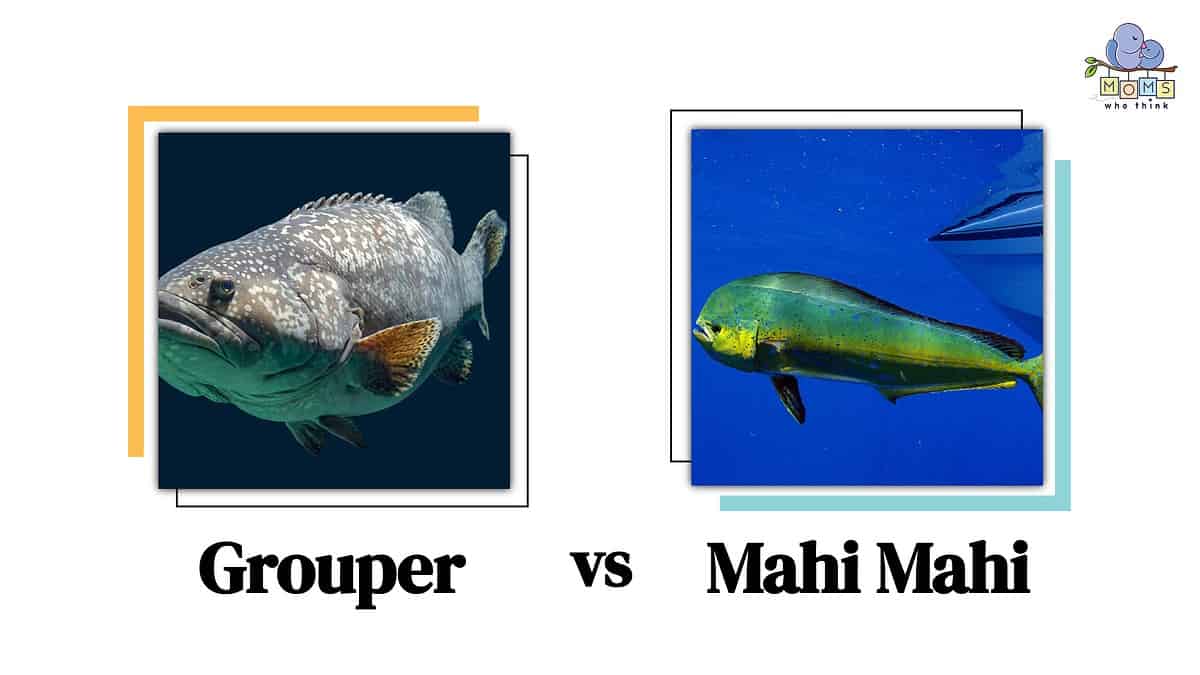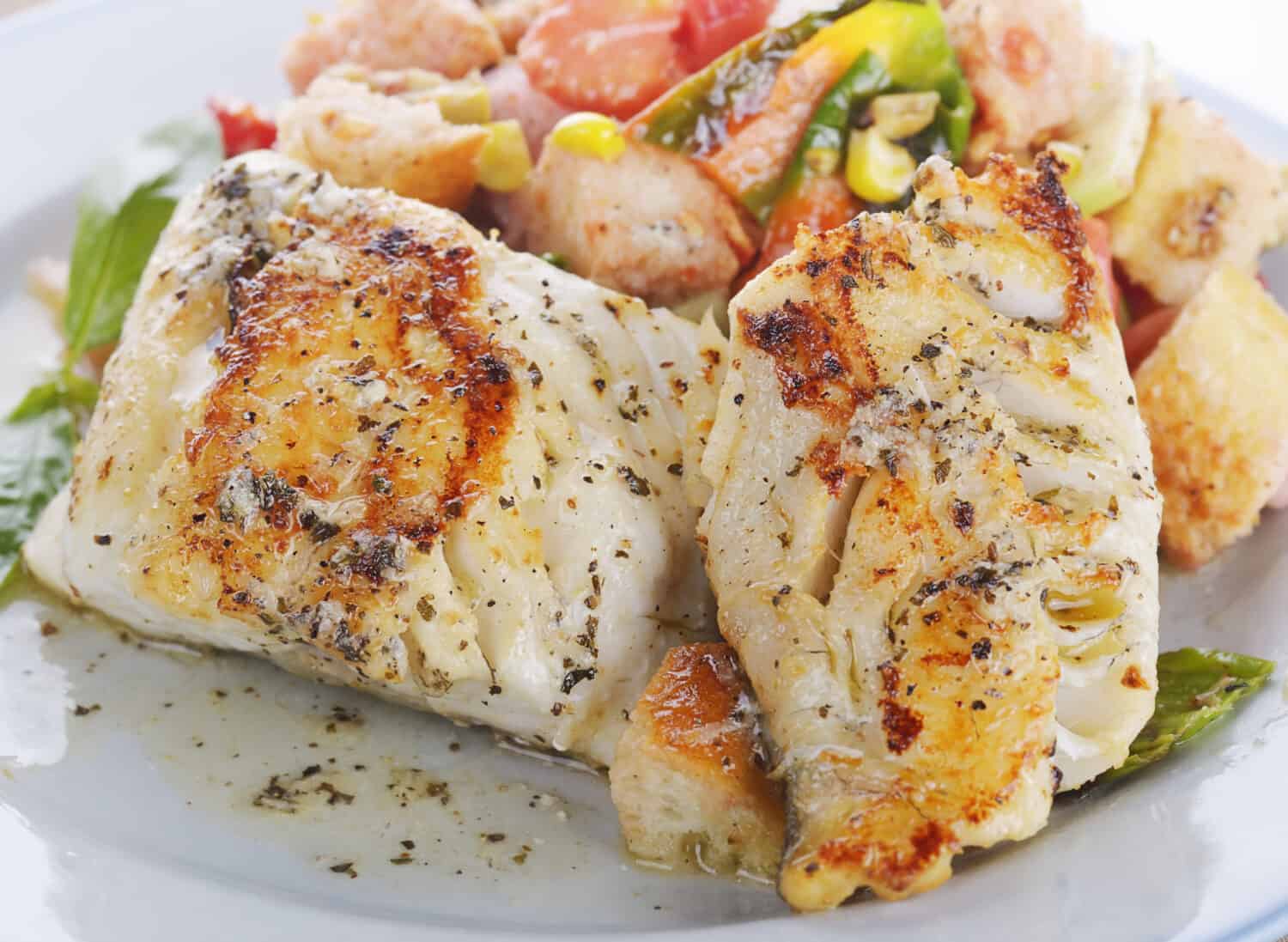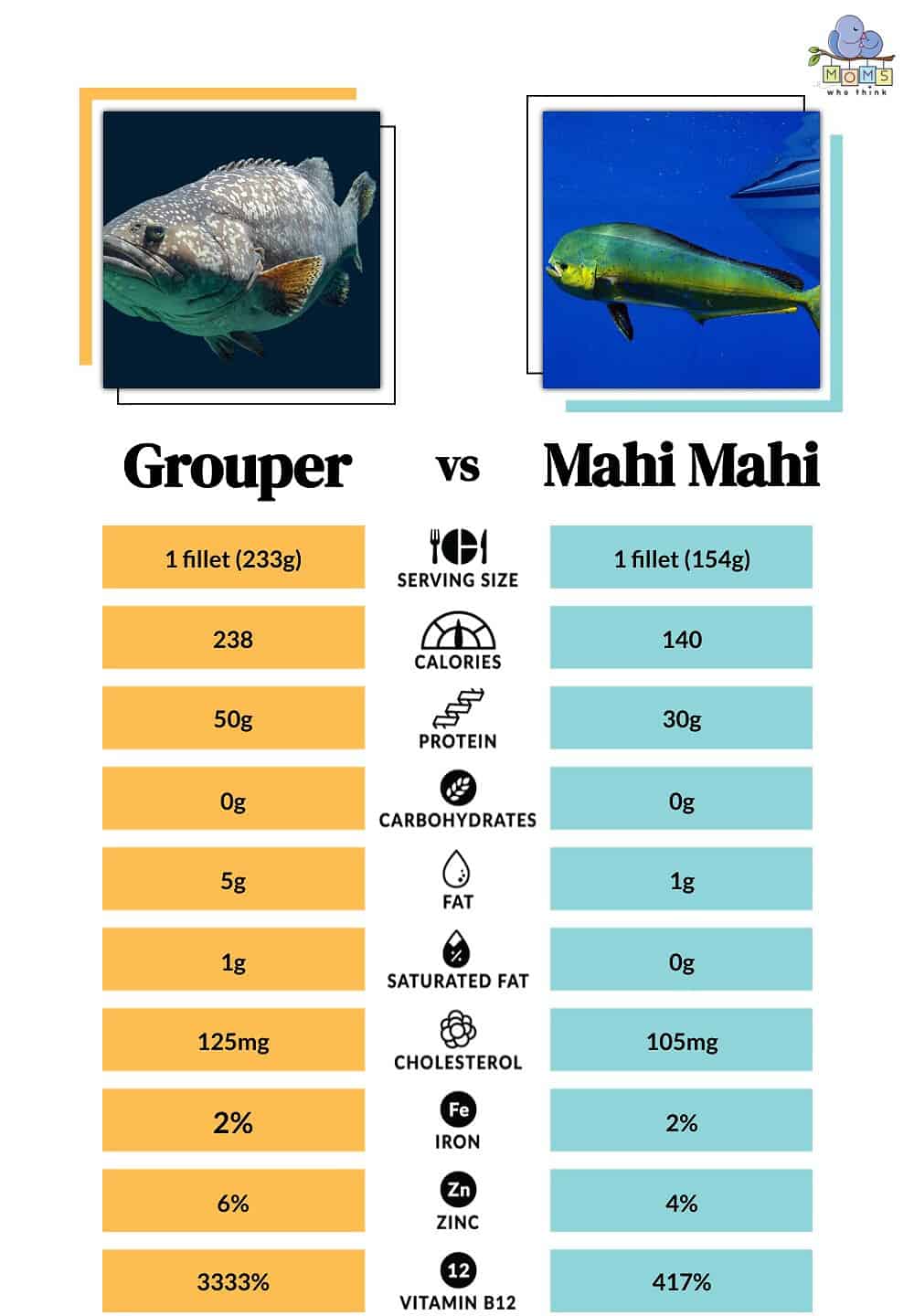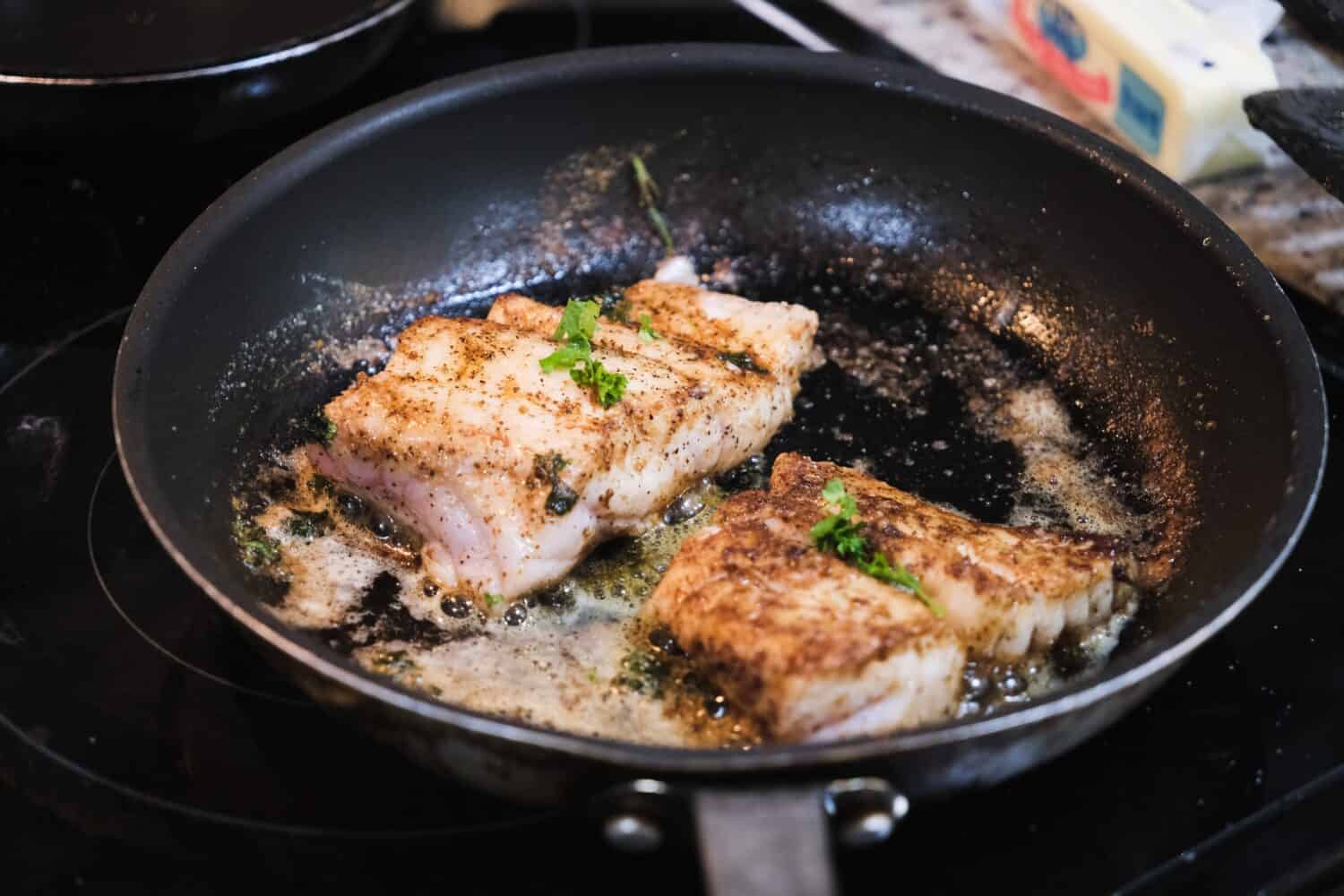Reviewing the menu at your local seafood restaurant may feel overwhelming. There are so many different types of fish to choose from. Two fish you may commonly see are grouper and mahi mahi. But how are these fish different? And do they taste the same?
In general, while both grouper and mahi mahi are mild in flavor, you'll notice that mahi mahi tends to be a cheaper item on the menu when dining out. But that's not all that sets these two types of fish apart.
- The must-have convenient reference guide for every home cook!
- Includes more than 8,000 substitutions for ingredients, cookware, and techniques.
- Save time and money on by avoiding trips to grab that "missing" ingredient you don't really need.
To help you decide which fish dish to order or prepare at home, here's everything you need to know about grouper and mahi mahi.

©
What is Grouper?
Grouper is a type of sea bass that originates from the Serranidae family. It's often found in the Gulf of Mexico and off the coasts of South Africa. The Florida Department of Agriculture and Consumer Services notes that grouper is one of the most popular fish consumed in Florida. In fact, Florida is the largest harvester of grouper, supplying more than 85% of this fish to the United States.
While more than 400 species of grouper exist, the most common types are red and gag grouper. Other types include black grouper, scamp, and snowy grouper. Additionally, grouper is known for its mild and slightly sweeter taste. It's versatile to cook with as well and can be found fried, grilled, broiled, baked, or steamed. However, it does have tough skin, so this should always be removed before cooking at home.
What is Mahi Mahi?
Also known as the “dolphin fish,” mahi mahi is a warm water fish that's found most often off the coast of Hawaii's shores. According to the National Oceanic and Atmospheric Administration, most of the mahi mahi fish found in the U.S. originates from Hawaii.
Mahi mahi can also be found in areas of the Caribbean, Mediterranean, and South Pacific. Its yellow-like hue gives it the nickname “dorado,” which means gold in Spanish. In Hawaii, however, the word mahi means “strong” as this type of fish is considered a powerful swimmer.
Mahi mahi is also mild in flavor and versatile in how it can prepared in the kitchen. When cooked properly, mahi mihi is flakey yet firm, making it a delicious choice for tacos.

©Svetlana Foote/Shutterstock.com
Grouper vs. Mahi Mahi: What are the Differences?
Both grouper and mahi mahi are mild in flavor and versatile while preparing. But there are a few other ways these fish differ, including:
Where They're Sourced
As mentioned, both types of fish are found in different areas of the world. In the United States, grouper comes primarily from the Gulf of Mexico and is a popular choice in Florida, while mahi mahi is found predominantly in Hawaii.
Additionally, grouper is most often found during warmer months, from April through October. Mahi mahi, however, is often caught during the summer and fall months.
Price
In general, mahi mahi is a less expensive fish to purchase and order off the menu than grouper. Due to its higher price point, grouper has even been known to be mislabeled. The Florida Department of Agriculture and Consumer Services warns against purchasing grouper that's priced suspiciously low. While mislabeling is illegal, it's been discovered that some have sold Asian catfish under the name of grouper.
Keep in mind that regardless of which fish you're purchasing, pricing may vary depending on whether the fish is in season or not. It will also vary depending on how close to the source you are and how difficult it is for your local grocer or restaurant to obtain the fish.
- The must-have convenient reference guide for every home cook!
- Includes more than 8,000 substitutions for ingredients, cookware, and techniques.
- Save time and money on by avoiding trips to grab that "missing" ingredient you don't really need.
Culinary Use
Both grouper and mahi mahi are versatile fish and can be cooked in a variety of ways in the kitchen. However, each one brings its own specialty to the table.
Grouper is often pan-fried, grilled, or baked. It's a popular fish for sandwiches, too. Grouper fillets are breaded then fried and served on a bun with tomato, lettuce, and fresh tartar sauce.
Mahi mahi is usually grilled or broiled. It's often found as the main ingredient in fish tacos due to its less fishy taste.
Grouper vs. Mahi Mahi: Nutritional Value
Grouper is an excellent source of omega-3 fatty acids. However, this leads it to be higher overall in fat and calories than mahi mahi. Grouper is higher in protein and provides larger amounts of zinc and vitamin B12, though. Here's a breakdown of their nutritional value:

©
Health Benefits of Both Grouper and Mahi Mahi
In general, both fish are found to be a lower-calorie food item. And with high amounts of protein, healthy fats, and vitamins, consuming fish is a healthy choice that can be part of a heart-healthy diet. WebMD reports that the rich omega fatty acids and high levels of vitamin B12 can lead to improved brain and heart health. Omega-3 fatty acids from fish can also lead to a reduced risk of depression.
Keep in mind, however, that these types of fresh fish can also have higher amounts of mercury in them. While this doesn't pose much risk to healthy adults, high mercury levels can impact children and pregnant women. To keep your mercury consumption in check, be sure to eat fish in moderation.
How to Prepare Grouper
Grouper is incredibly versatile and can stand up to many different cooking methods. When pan-frying, pat the grouper fillets dry and then rub them with oil combined with lemon juice or seasonings of your choice. The fish can then be pan-fried in cooking oil for about 4 minutes on each side.
Grilled grouper is another great option, but keep in mind that fish tend to stick to grill racks. Season your fish and wrap it in tin foil before placing it on the hot grill. Let it cook for about 8 to 10 minutes before removing it.
You can also bake grouper by adding your own seasoning or marinade, and then letting it cook in the oven for about 6 minutes at 450 degrees.
When cooking grouper, just remember that it's a lean fish, so if it's overcooked, it tends to dry out quickly. It also has tough skin that must be removed before consuming.
How to Prepare Mahi Mahi
While most mahi mahi filets will be bone-free, you may still notice a bone here and there. These are easier to remove after cooking. Similar to grouper, mahi mahi can dry out easily if over-cooked and the skin should be removed before eating.
Mahi mahi can be prepared similarly to grouper above, but these filets tend to be thinner, so this fish requires less cooking time.
One simple way to prepare this type of fish is by brushing it with a sauce or marinade and then broiling it in the oven until cooked through. Additionally, mahi mahi can be deep-fried to make delicious tempura.
Can You Substitute Grouper for Mahi Mahi and Vice Versa?
Absolutely! These two fish are mild and similar in flavor. They're also versatile and easy to prepare in several different ways. You may also find that one kind is more available or costs less than the other depending on where you live making it an easy decision to swap one for the other.
Best Substitutes for Grouper
As mentioned, grouper can be more expensive than other types of fish. While mahi mahi is a suitable substitute, there are a few other cost-effective options, including:
- Cod
- Catfish
- Haddock
- Tilapia
- Red Snapper
Best Substitutes for Mahi Mahi
Whether you're in a pinch or simply want to try something new, mahi mahi can also be substituted with:
- Halibut
- Swordfish
- Snapper
- Cod
- The must-have convenient reference guide for every home cook!
- Includes more than 8,000 substitutions for ingredients, cookware, and techniques.
- Save time and money on by avoiding trips to grab that "missing" ingredient you don't really need.
Which One to Choose at Your Next Meal
When it comes to grouper and mahi mahi, both types of fish are delicious, mild in flavor, and versatile to prepare in the kitchen. While grouper has higher amounts of healthy fats and protein, both types can also be a smart choice for a heart-healthy diet. Next time you're out to eat and you're caught up in deciding which one to order, just know that either choice is sure to be delicious!
Print
Greek Grouper
- Total Time: 20 minutes
Ingredients
- 4 (4 ounce) grouper fillets
- 2 teaspoons salt-free Greek seasoning
- Cooking spray
- 1 (10 ounce) package frozen chopped spinach, thawed and squeezed dry
- 1 plum tomato, coarsely chopped
- 1/4 cup (1 ounce) crumbled basil- and tomato-flavored feta cheese
- Cooked orzo (optional)
Instructions
- Sprinkle both sides of the fillets with seasoning.
- Coat a large nonstick skillet with cooking spray, and place over medium-high heat until hot. Add fish, and cook 3 minutes; remove skillet from heat.
- Turn fish; top with spinach tomato, and cheese. Return to skillet to heat; cover and cook 3 to 4 minutes or until spinach is hot and fish flakes easily when tested with a fork.
- Serve immediately over cooked orzo.
- Prep Time: 10 minutes
- Cook Time: 10 minutes
- Category: Main Course
- Method: Frying
- Cuisine: American
The image featured at the top of this post is ©Adam Madey/Shutterstock.com.


